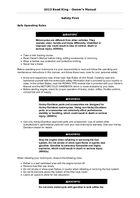To decrease hours press the Hrs soft key. When the hour is correct, release the soft key.
To increase the minutes in the display press the Min+ soft key. To decrease minutes press the
Min soft key. When the minute is correct, release the soft key.
Turn Receiver ON/OFF
To turn the receiver ON, turn the ignition switch to IGNITION or ACCESS and press the ON
button on the front panel. To turn the receiver OFF, press the ON button.
If the receiver is ON when the ignition is turned OFF, the receiver will power up when the ignition
switch is turned to IGNITION.
Select a Frequency Band
Using the right thumb, press the MODE SEL switch on the right hand grip and release to cycle to
the desired frequency band (mode) or press the soft key next to the frequency band displayed in
the LCD to select a frequency band.
See B in LCD Display Examples. The LCD highlights the selected band.
NOTE:
Refer to Receiver Frequency Bands. When a CD/MP3 disc is present in the CD slot and/or an
auxiliary player is plugged into the AUX port, the MODE SEL switch will cycle through the CD and
AUX modes as well as the frequency bands.
Volume
See D in LCD Display Examples. At any time the receiver is playing, the volume can be
adjusted by pressing the AUDIO switch up (+) to increase volume or down ( ) to decrease
volume.
AM vs FM Reception
Commercial radio broadcasting is either AM (Amplitude Modulation) or FM (Frequency
Modulation).
AM
AM radio waves reflect off the ionosphere which results in consistent signal reception at a long
range (up to 100 miles or 160 kilometers).
However, AM radio can be displaced by loud humming, popping and crackling noises. This is
electrical interference caused by noise from vehicle ignitions, electric signs, power lines and
electrical storms.
FM
The advantages of FM radio are high fidelity sound, stereo reception, a wide range of
broadcasting formats and a signal that is free of electrical interference.
The disadvantage of FM radio is its short range. FM radio waves travel in straight lines, called
"line of sight," therefore, FM signals cannot be received over the horizon. At the limit of a station's
range, the reception may fade in and out when objects pass between the transmitter and the
motorcycle.
FM Stereo vs FM Mono




















































































































































































